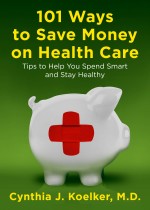Too much or too little? Either way it can be dangerous, even fatal.
Most of my patients who have an abnormal serum potassium level in their blood are unaware of the fact. Typically, they are taking diuretics (water pills) which deplete the body of potassium as well as water (sodium, too, at times). I check their blood on a regular basis to identify the problem before it causes symptoms.
What are the symptoms? Muscle cramps or weakness are typical. When potassium levels are excessively high or low, it may throw the heart out of rhythm, not a good thing.
Potassium alone is an ion, so is usually found as a salt, with a chemical structure such as this diagram of potassium chlorate.

People who are advised by their physician to avoid salt (sodium chloride) sometimes substitute potassium chloride instead. Interesting thing about potassium chloride: some people experience the taste as similar to regular salt. Others, like me, find the taste gaggy awful, and would rather do without altogether.
Although high or low potassium levels can be life-threatening, there is good news: the human body was designed to regulate the level within a very narrow range. Fortunately, most people don’t have to think about this. It is extremely rare for a healthy person on a normal American diet to develop abnormal levels. However, even a healthy person who develops vomiting and/or diarrhea can run into a problem, as excess potassium is lost. Laxative abuse can also cause hypokalemia (low potassium).
Fruits and vegetables have a good amount of potassium, especially bananas and citrus fruits. Sports drinks that boast claims of ‘electrolytes’ contain potassium. Regular Gatorade, for example, contains 30 mg. of potassium per 50 calorie serving, and 100 mg. of sodium. This really isn’t very much compared to foods. one banana has 422 mg. according to the USDA National Nutrient Database at: http://www.nal.usda.gov/fnic/foodcomp/Data/SR17/wtrank/sr17a306.pdf. Even a Snickers bar has more (184 mg.)
This may look like tomatoes, but it’s pomegranate – both high potassium foods, as is the avocado below.

When the kidneys do not function properly to cleanse the blood, potassium levels can rise. This, however, is uncommon. Certain blood pressure and other medications may cause a similar problem.
But by far the most common situation (other than excess diarrhea) is medication-induced potassium loss. Diuretics are usually to be blamed, although ACE-inhibitors and sometimes ARBs sometimes are responsible.
Many high blood pressure patients can maintain a normal potassium level simply by eating a banana daily. However, doctors often prescribe potassium pills for those who do not or cannot maintain an adequate level with diet alone.
Doctors do not prescribe potassium in terms of milligrams. This is because potassium supplements come as salts (potassium chloride, for example). Both chemicals are included in the total weight. Since there are different formulations and salts, the total weight is not the important factor, but rather the milli-equivalent (mEq.) amount.
Most patients who need supplementary potassium require 10 to 40 mEq. per day.
But how much does a healthy person with good kidneys require? Kidneys, by the way, rid the body of extra potassium in a normal situation. They also conserve potassium when intake is lower.
The answer to how much is needed depends on the size and age of the person.
The USDA lists AI (advisable intake) and UL (upper limit) for various ages. For most adults, the AI is 4.7 grams, with no upper limit set (in healthy people, not on medicines). That would be about 10 bananas a day, which sounds ridiculous. But 5 servings of fruits and vegetables a day is recommended anyway (and is more than most Americans consume). It has ben suggested that a relatively higher potassium intake may help keep the blood pressure lower.
No RDA (recommended daily allowance) has been set because is unknown. The amounts for other ages are listed at:
http://www.iom.edu/Global/News%20Announcements/~/media/442A08B899F44DF9AAD083D86164C75B.ashx
In summary, healthy people not on medicine don’t have to worry about their potassium – just eat a healthy diet. For persons on potassium-depleting or potassium-sparing drugs, you should have your doctor monitor your potassium regularly. Depending on the medication and your response, this could be monthly or yearly or anywhere in between.
Potassium supplements are inexpensive. If you need them, take them. The cost of an ER visit for a low potassium is just not worth skimping on medication or bloodwork. Sometimes doctors order a full panel of electrolytes, but you can simply have your potassium checked more cheaply (about $20).
Related articles by Zemanta
- Potassium in diet – All Information (umm.edu)
- Hyperkalemia – All Information (umm.edu)




